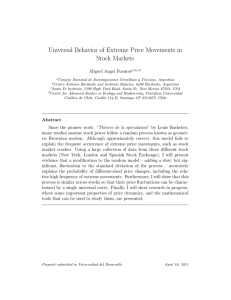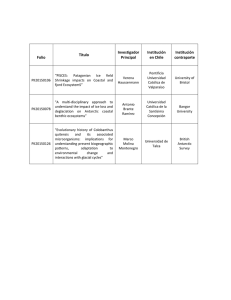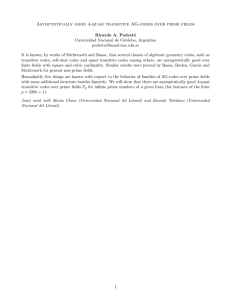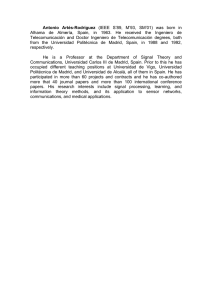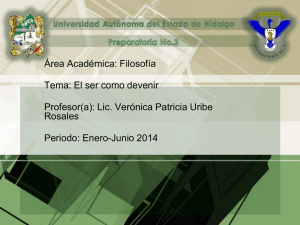"A.P.D. Mourelatos, The Route of Parmenides. Revised and
Anuncio
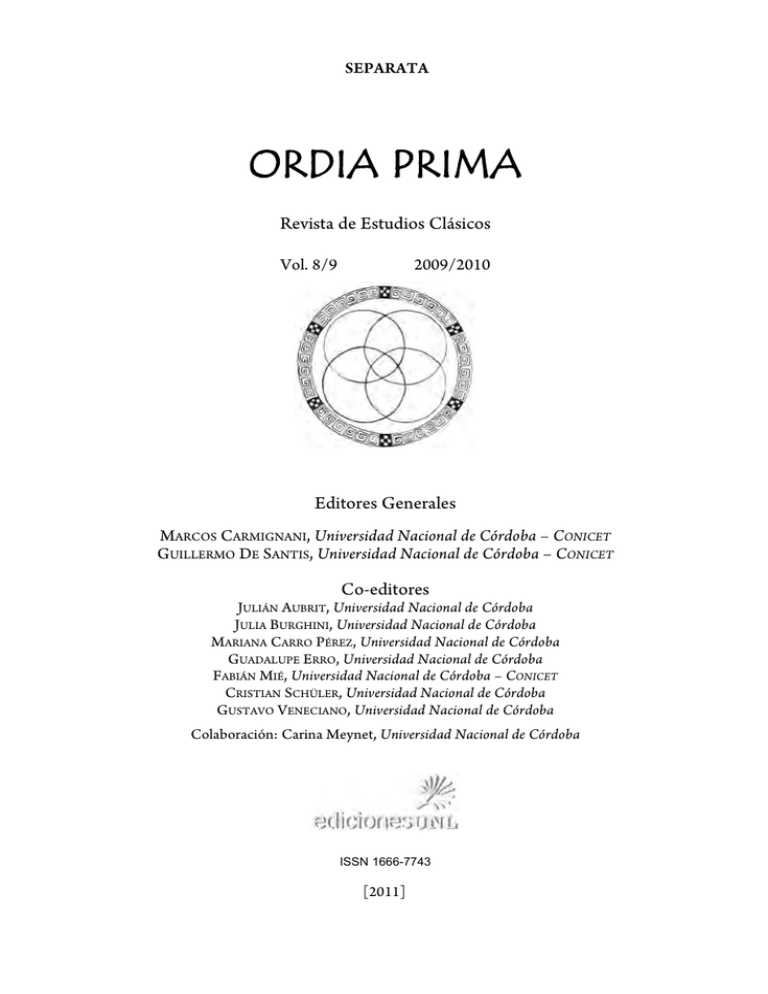
SEPARATA ORDIA PRIMA Revista de Estudios Clásicos Vol. 8/9 2009/2010 Editores Generales MARCOS CARMIGNANI, Universidad Nacional de Córdoba – CONICET GUILLERMO DE SANTIS, Universidad Nacional de Córdoba – CONICET Co-editores JULIÁN AUBRIT, Universidad Nacional de Córdoba JULIA BURGHINI, Universidad Nacional de Córdoba MARIANA CARRO PÉREZ, Universidad Nacional de Córdoba GUADALUPE ERRO, Universidad Nacional de Córdoba FABIÁN MIÉ, Universidad Nacional de Córdoba – CONICET CRISTIAN SCHÜLER, Universidad Nacional de Córdoba GUSTAVO VENECIANO, Universidad Nacional de Córdoba Colaboración: Carina Meynet, Universidad Nacional de Córdoba ISSN 1666-7743 [2011] Editorial CONTENIDOS 9 Luigi Enrico Rossi. In memoriam 11 Resúmenes vol. 8 / 9 13 Artículos vol. 8 ANDRÉ MALTA CAMPOS, A linguagem fora de controle: o discurso de Agamênon no Canto 2 da Ilíada 25 ESTEBAN BIEDA, Escuchar, comprender, opinar el lógos. Distintos niveles de conocimiento en algunos fragmentos de Heráclito de Éfeso 51 MARÍA INÉS CRESPO, El cliché metafórico en Siete Contra Tebas: inclusión estructural y función extratextual 81 MARCELA RISTORTO, La función del relato del falso mercader (vv. 604-621) en Filoctetes de Sófocles 121 MIGUEL RUIZ STULL, Gorgias y la suspensión de enunciado 133 ROMINA MAGALLANES & ROMINA DE ANGELIS, No es verdadero ese decir: Helena como personificación del lógos 149 ANA LUISA COVIELLO, Semiótica de la significación versus semiótica de la comunicación: una oposición perjudicial en el estudio de la intertextualidad de la literatura latina 165 Artículos vol. 9 CAROLINA DELGADO, El emplazamiento político de la poetología platónica: ¿una concepción selectivo-normativa? 189 MOURELATOS, A. P. D., The Route of Parmenides. Revised and expanded edition (originally published 1970). With a new introduction, three supplemental essays, and an essay by Gregory Vlastos. Las Vegas: Parmenides Publishing, 2008. Pp. lix + 408. Pb. ISBN 978-1-93097211-7. US$42.00. From Plato and Aristotle to Hegel, Nietzsche, and Heidegger, philosophers agree in considering Parmenides to be among the most important – if not the most important – of the early philosophers usually called “Presocratics”. But this consensus has occurred on the basis of a common presumption: the belief that Parmenides was a monist who invented the transformation of the world into a single, compact substance, who denied movement and plurality and propagated an ontology that petrifies phenomena. Parmenidean philosophy as an important and at the same time absurd entertainment – this is the credo that has always been underlying the communis opinio of philosophers and scholars. In the last century, however, this consensus has experienced several ruptures. In 1916, Karl Reinhardt1 fundamentally transformed the landscape of Parmenides research by reminding us that in the poem the part of Aletheia (“Truth”) is followed by the (originally much longer) part of Doxa (“Opinion”), and that no adequate understanding of Parmenidean philosophy can be attained before we give a convincing account of the relation between these two parts. Looking back at 20th century scholarship on Parmenides, we can name only one book with similar impact – and this is the 1970 monograph of Mourelatos now reprinted. This new edition not only makes this seminal book again available, but also invites us, 40 years later, to ask anew the question: why does Route still remain not only “the most interesting monograph about this thinker written since K. Reinhardt”,2 but also the most important one? The original Route is reprinted as Part I of the new edition, with only “modest... revisions” (p. xi). This part is surrounded by a new “Preface and Afterword” (pp. xi-l) and by the following Part II, which contains “Three Supplemental Essays”, originally published in the 1970s, which seek “to supplement, to strengthen, and in some respects to modify theses” of the original __________________ 1 K. REINHARDT: Parmenides und die Geschichte der griechischen Philosophie. Frankfurt: Klostermann 19854 [partly translated in: A. P. D. Mourelatos (ed.): The Pre-Socratics. A Collection of Critical Essays. Princeton: Princeton University Press 19932, pp. 293-311]. 2 See the review of A. GRAESER: “Vier Bücher zur Eleatik”. Göttingische Gelehrte Anzeigen 230 (1978), pp. 44-45. ORDIA PRIMA 8/9 (2009/2010) 301-318 302 Reseñas Bibliográficas Route. The concluding Part III presents a previously unpublished important essay of Gregory Vlastos focusing on fragment B8.38-41, i.e. on the problem of naming in Parmenides. In his own “editing note”, Mourelatos illustrates the importance of this essay in conjunction with other, more recent interpretations (Vlastos’ hesitation to publish the text attests to an attitude definitively lost in the contemporary climate of “publish or perish”). The Afterword, for its part, contains a series of “retractations”, “retrospectives” and “afterthoughts” from the author’s current perspective, while the Preface sheds light on the “pre-history” of the book, and especially on the dissertation on Parmenides that preceded it (accomplished 1963). The book thus presents a comprehensive view of the author’s 45-year engagement with the poem. The Preface bears signs of an intellectual autobiography and reveals Mourelatos’ early occupation with Kant and Wittgenstein, as well as the deep influence exercised upon him by his teacher Wilfrid Sellars (to whom the present edition is dedicated). In the course of this “Preface and Afterword” (pp. xlii-xlix), Mourelatos goes back once more to Kant and Sellars and employs philosophical schemes outlined by them in order to illustrate aspects of Parmenidean philosophy – and notably the notorious Doxa. In an interesting reflection, Mourelatos accepts “anachronism” in doing history of philosophy as a way “to explore conceptual structure by modeling an ancient theory on a modern one. I believe that there is more of potential gain and benefit than of loss and harm in this sort of comparative analysis” (pp. xlvi-xlvii). One might add that such an “anachronistic” hermeneutic stance is not only permitted, but even necessary – as an essential element of a history of philosophy that regards itself as part of philosophy proper, and not as a form of mere doxography. The original book of Mourelatos has been frequently and variously analyzed, evaluated, appraised – and above all employed in most of the hermeneutic approaches to Parmenides in the last 40 years. In view of this new edition, it seems to me that one more typical presentation of the book’s contents would not contribute much to what we already know. It might be more important to reflect upon the merits of the Route as they have emerged over these years. What is the Wirkungsgeschichte of the book, or: why is Route probably the second most important book on Parmenides written in the 20th century? The answer to this question should probably start with the last text of the volume: the article “Some Alternatives in Interpreting Parmenides”, first published in an eminently important special issue of The Monist (1979). In that paper, Mourelatos formulates four theses of the “standard Anglo-American interpretation of Parmenides” at that time, which allow for the widely shared conclusion: “Monism, understood as the doctrine that all things are one thing, follows”. This conclusion, however, was not an invention of the 1960s or 1970s, but a quasi-perennial motto of all interpretations of the poem – starting with Plato and Aristotle who, despite their divergences, share the assump- Reseñas Bibliográficas 303 tion that Parmenides was a philosopher who held that “everything is one” (hen to pan, first in Parm. 128a-b). To be short: what I would acknowledge as Mourelatos’ most important contribution to scholarship is that he challenged (and probably made obsolete) this notion of a crude Parmenidean monism. Mourelatos is a philosopher with a rare, exceptional sense of the ancient Greek language. It is not surprising that his first important (and lasting) achievement has been the location of the poem within the broad framework of the archaic Greek literature. The text contains numerous and different traditional motifs, none of which would alienate the reader or listener of that time. But these motifs undergo significant, crucial transformations such that they enter into clear tension with that tradition. While philologists usually seek to establish the affinities of the fragments with Homeric or Hesiodian Epos, Mourelatos has an exceptional sensitivity for the linguistic and conceptual shifts that take place in these “elective affinities”. The analysis of this double relationship (appropriating tradition and decisively transforming it) leads Mourelatos to a completely convincing conclusion: “Parmenides uses old works, old motifs, old themes, and old images precisely in order to think new thoughts in and through them” (p. 39). The prevailing motif of the poem is that of “the-journey”. The topography in the proem is “blurred beyond recognition”, and “the blur is intentional” (pp. 15f.). In view of this insight, it is remarkable that serious scholars still seek to identify this journey either as an anabasis anticipating the Platonic Phaedrus, or as a katabasis reproducing Pythagorean mystical motifs. The importance of “the-journey” lies exclusively in its ontological significance, inasmuch as Parmenides expounds his ontological project as a crisis, a decision between two “routes of quest”: between the route of Being, which generates truth, and the route of Non-Being, which leads to a dead-end and brings “no tidings”. The crucial insight of Mourelatos is that Truth is neither a specific conclusion nor a particular premise of a syllogism, but rather the very route of Being and the quest accomplished along this route. But if esti in B2 is the route, then the philosopher who allegedly denied movement and plurality and propagated an ontology that completely petrifies phenomena shows himself to be a philosopher of permanent search, who insists on the necessity of a road on which we permanently have to move. The route of Being thus represents a scheme of “explanation and interpretation” (p. 56), of a “theoretical examination” (p. 58) that yields propositions of the form “– is –” or “x is F”, in which F is the “characteristic nature, true identity, intrinsic reality, or essence” of each and every x (pp. 334, 341). The monolectic esti functions as the mere form or frame of propositions that characterize their subject in positive terms and provide “a complete exposure of, and insight into, the identity of a thing to such an extent and in such a manner 304 Reseñas Bibliográficas that no further questions with respect to that thing need or may arise” (p. 57).3 The rejection of the second route of Non-Being, in fact a rejection of the cosmological significance of negative predications, will be established in a paper of 1973 to be a result of “The Naïve Metaphysics of Things” shared (in its “refined” version) by Parmenides (pp. 324-332). Mourelatos thus invites us to view Parmenides as a sort of philosopher of science or as an early methodologist, who assigns his “Is” merely the role of a “conveyer” (p. 59). But the immense merit of this interpretation is that it reveals the significance of the theme of the “route” and the notion of “seeking” or “inquiry” (dizêsis) on the route of Being. In his Afterword, Mourelatos remarks that his “speaking in that essay of a ‘Standard Interpretation’ turned out to be naively premature”. Perhaps Mourelatos’ own modesty prevents him from seeing that it was his Route which made that “consensus [...] either a mirage or evidently short-lived”, and that his own work contributed essentially to the “richness and variety of interpretations of Parmenides that were developed subsequently – in the 1980s, the 1990s, and in this century” (p. xxvi). Above all, what Mourelatos made impossible was the crude monism previously ascribed to Parmenides; and this is a merit of the whole book, and not only of the respective small chapter (pp. 130-133) introduced by the phrase “Parmenides is a monist in some sense – but exactly in what sense?”. The answer given to this question is that “Parmenides’ monism is essentially a nondualism [...] compatible with numerical plurality”. The impact of this thesis is easily testified to in recent interpretations as important as Patricia Curd’s notion of “predicational monism”.4 But the significance of the Route is not due solely to its crucial contribution to the extensive overall reassessment of the philosophical content of the poem in the last decades.5 Mourelatos is a perceptive student not only of the spirit __________________ 3 Mourelatos initially called this “enriched” meaning of esti “speculative predication”, in the sense of a “theoretical examination” or “transempirical inquiry”. Although he insisted that “the associations of the term with German idealism” should be avoided, he had to abandon the term in an essay of 1976. In the reprint of that essay in the present edition (p. 341, n. 18), however, the self-criticism has become much “softer”. Has the author come to regret abandoning the term? 4 “Each thing that is can be only one thing; it can hold only the one predicate that indicates what it is, and must hold it in a particularly strong way” (The Legacy of Parmenides. Eleatic Monism and Later Presocratic Thought. Princeton: Princeton University Press 1998, p. 66 and passim). For some interesting reservations raised by Mourelatos regarding this parallel interpretation, see his “Parmenides and the Pluralists” (Apeiron: A Journal for Ancient Philosophy and Science 32, 1999, pp. 117-129). 5 The pivotal role of Mourelatos in this reassessment is also evident in my own attempts: Die erste „zweite Fahrt“. Sein des Seienden und Erscheinen der Welt bei Reseñas Bibliográficas 305 but also of the letter of the fragments, and his interpretations seem to have elucidated many unresolved riddles that puzzled scholars for ages. I will mention here only a few of them: ◆ B1.32 The verb chrên is a case of a “counterfactual” irrealis (pp. 205-210). A participle perônta is here impossible, for peran never means “pervade” in the sense of “pass through and then occupy” or “govern”, but always “get through and leave behind”, or “get on the other side of” (p. 213). Consequently, the better attested reading per onta is clearly preferable.6 ◆ B2 On the subject of esti: “if Parmenides intended a definite subject it is odd that he should have concealed it, and that he should have expected his hearers or readers to guess it. It is hard to see the point of such intellectual hideand-seek” (p. 273). ◆ Β8 After Mourelatos, the structure of the fragment around four distinct “proofs” is definitely established: a. “ungenerable” (ll. 5-21); b. “indivisible” (22-25); c. “immobile” (26-31); d. “complete” (32-33 and 42-49). Within the first of these “proofs”, understanding gignesthai ti par’ auto (8.12) in the sense of prosgignesthai, “accrual” or “accretion”, has solved a long-standing series of puzzles arising out of this part of the text. The same is the case for the irritating phrase en hôi pephatismenon estin, which should be understood in the sense “to which it stands committed” (pp. 171-172). As for the notorious comparison of Being with a sphere in 8.43, Mourelatos has shown that this comparison refers exclusively to the completeness of both, and thus does not involve an obtuse sphericity (viz. materiality) of Being (p. 126). The Route still contains the most convincing evaluation of the poetic quality of the poem (pp. 34-37) – and a plenty of other insights, which cannot be mentioned in this context. I will conclude with the excellent analysis of the “positive (though defeasible) sense” of the so-called dok-words (pp. 194202), but also remark critically that, in the last chapter of the Route, Mourelatos remained unwilling to acknowledge the positive cosmological __________________ Parmenides. München: Wilhelm Fink 1997. Parmenides, Cosmos, and Being. A Philosophical Interpretation. Milwaukee: Marquette University Press 2007. 6 Mourelatos translated the second half of line B1.32 as “just being all of them altogether” (p. 216), and later “if only all of them were in every way” (“Parmenides and the Pluralists”, p. 125; see also the Afterword, p. xxxii). I myself favor the reading “all of them altogether as beings”. 306 Reseñas Bibliográficas content of the Doxa; he presented this part of the poem as a case of philosophical irony or as a “study in deception” which, in using paradoxes and ambiguities, illustrates the “self-deception, indecisiveness, and confusion” incorporated in the world-view of mortals. One might assume that this partial (and in my view inadequate) interpretation results from the author’s highly developed sense for the fine nuances of the Greek language. But Mourelatos would not be what he is, i.e. a highly perceptive interpreter, if he failed to question his own theses. In introducing the Afterword, he now admits (p. xxxviii) that he had been “too dismissive of the scientific content, especially of the astronomy, on the second part of Parmenides’ poem”. A large part of his work in the 1990s on the Presocratics has successfully tried to fill this gap, and the author now believes that “the doctrines [of the Doxa] constitute a wellwoven inferential fabric”. Mourelatos seems unwilling to cease providing us with fine masterpieces of scholarship on Greek philosophy! PANAGIOTIS THANASSAS Aristotle University of Thessaloniki [email protected] BOERI, M. D., Apariencia y realidad en el pensamiento griego. Investigaciones sobre aspectos epistemológicos, éticos y de teoría de la acción en algunas teorías de la antigüedad. Buenos Aires: Colihue, 2007. Pp. 384. Pb. ISBN 978-950-563-404-0. $77.00. En lo que sigue haré una presentación breve del texto en cuanto a su estructura formal. Luego, presentaré una descripción de los contenidos dividiendo el trabajo en cuatro partes: la primera tendrá en cuenta la introducción, y las tres restantes, los contenidos desarrollados en las tres subdivisiones importantes que posee la obra. El texto, de tapa blanda, posee 384 páginas y cuenta con un índice de abreviaturas (pp. 9-10), un prólogo (pp. 11-15), una introducción (pp. 17-36) y el cuerpo del texto en tres partes: 1a sobre Sócrates y Platón (pp. 39-141), 2a sobre Aristóteles (pp. 145-279) y 3a sobre el estoicismo (pp. 283-341); un buen repertorio bibliográfico (pp. 343-355), y tres índices: uno de nombres antiguos (pp. 357-358), uno de nombres modernos (pp. 359-363) y uno de lugares (pp. 365376). La presencia de estas tres últimas secciones asegura al lector que el texto pueda ser abordado desde distintas entradas con facilidad. Por otra parte, está bien dotado de notas al pie y de referencias a obras antiguas y contemporáneas dentro del cuerpo del texto; este hecho asegura que las ideas vertidas puedan ser puestas en discusión con muchas otras perspectivas e interpretaciones diferentes. JORGE TORRES, La aporética del tiempo: un análisis reconstructivo de Fís., Δ 10, 217b29-218b20 211 ANDREA CUCCHIARELLI, Old Frog Songs. The Reception of Greek Old Comedy in Rome 235 NIALL W. SLATER, Seneca’s Apocolocyntosis as Dystopic Prelude to a Neronian Golden Age 257 PAUL MURGATROYD, Ernest Dowson and Latin Poetry 281 Reseñas bibliográficas MOURELATOS, A. P. D., The Route of Parmenides. Revised and expanded edition (Panagiotis Thanassas) 301 BOERI, M. D., Apariencia y realidad en el pensamiento griego. Investigaciones sobre aspectos epistemológicos, éticos y de teoría de la acción en algunas teorías de la antigüedad (Manuel Berrón) 306 CARISIO, Arte Gramática, Libro I. Introd., trad. y notas de J. Uría (Julia Burghini) 310 GUTIÉRREZ, M. A., Libri minores / Aelii Antonii Nebrissensis. (Carina Meynet) 313 Lista de publicaciones recibidas Guía para colaboradores 319 321 Las colaboraciones deben ser enviadas a: Marcos Carmignani – ORDIA PRIMA – Perú 114 – 1º piso, depto. ‘‘B’’ – Nueva Córdoba – CP. X5000CGD – Córdoba – Argentina ([email protected]) ORDIA PRIMA cuenta con el aval institucional y académico de la Escuela de Letras de la Facultad de Filosofía y Humanidades de la Universidad Nacional de Córdoba, Argentina. © 2009/2010 by ORDIA PRIMA © Ediciones UNL, 2009/2010 9 de Julio 3563 – S3002EXA – Santa Fe – República Argentina ORDIA PRIMA 8/9 (2009/2010) se terminó de imprimir en junio de 2011 Impreso en Argentina Printed in Argentina Hecho el depósito que marca la ley 11723 COMITÉ CIENTÍFICO Santiago Barbero, Universidad Nacional de Córdoba, Argentina Alessandro Barchiesi, Università degli Studi di Siena, Italia Alain Billault, Université Paris-Sorbonne (Paris IV), France Paul Cartledge, Clare College, University of Cambridge, United Kingdom Elisabetta Cattanei, Università degli Studi di Cagliari, Italia Pablo Cavallero, Universidad de Buenos Aires, Argentina Mireille Corbier, Directrice de L’Année épigraphique, France Paula da Cunha Corrêa, Universidade de Sâo Paulo, Brasil Stavros Frangoulidis, University of Crete, Greece Michael Gagarin, University of Texas, USA Simon Goldhill, King’s College, University of Cambridge, United Kingdom Joan Gómez Pallarès, Universitat Autónoma de Barcelona, España Luca Graverini, Università degli Studi di Siena, Italia Philip Hardie, Trinity College, University of Cambridge, United Kingdom Stephen J. Harrison, Corpus Christi College, Oxford University, United Kingdom Karl-J. Hölkeskamp, Universität zu Köln, Deutschland David Konstan, Brown University, USA Maurizio Migliori, Università degli Studi di Macerata, Italia Alba Romano, Universidad de Buenos Aires, Argentina † Luigi E. Rossi, Sapienza, Università di Roma, Italia María Isabel Santa Cruz, Universidad de Buenos Aires, Argentina Richard Seaford, University of Exeter, United Kingdom Heinrich von Staden, Institute for Advanced Study, Princeton, USA Oliver Taplin, Magdalen College, Oxford University, United Kingdom Alejandro G. Vigo, Universidad de Navarra, España Francisco Villar, Universidad de Salamanca, España SUSCRIPCIÓN / SUBSCRIPTION ORDIA PRIMA se edita anualmente en diciembre. Precios de Suscripción en Argentina: Particular $ 50.00; Institucional $ 90.00. Suscripciones desde el extranjero: Suscriptores extranjeros (Foreign subscribers) Particular (Individual subscriber) Institucional (Institutional subscriber) 1 año US$ 50.00 / 35.00 € US$ 90.00 / 63.00 € Se requiere el pago adelantado para el envío. Para los pedidos de copias y de suscripción, cambios de dirección y publicidad, por favor, contáctese con Marcos Carmignani en las direcciones indicadas arriba. For orders of copies and subscription and address changes, please send your request to [email protected] Los índices y abstracts de ORDIA PRIMA están catalogados en l’Année Philologique. ORDIA PRIMA está catalogada también en Latindex, folio 12539, sitio web: www.latindex.org. ORDIA PRIMA fue evaluada por el CAICYT (Consejo Argentino de Información Científica y Técnica) como revista de Nivel 1.

